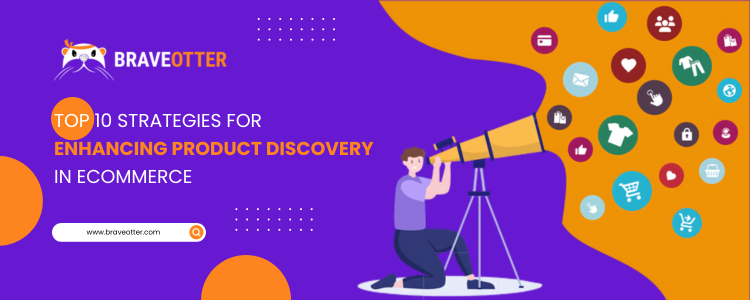Top 10 Strategies for Enhancing Product Discovery in Ecommerce

In the fast-paced world of e-commerce, ensuring that customers can easily discover the products they want—or those they didn’t know they needed—is crucial for success. Enhanced product discovery can lead to higher conversion rates, increased customer satisfaction, and a more engaging shopping experience. Here are the top 10 strategies to enhance product discovery in your e-commerce store:
1. Implement Advanced Search Functionality
A robust search engine is essential for helping users quickly find what they’re looking for. Utilize AI-powered search engines that handle natural language processing (NLP), autocomplete suggestions, and synonym recognition. Features like typo tolerance and personalized search results further refine the customer experience, ensuring that users find the most relevant products.
For example, Amazon uses AI-driven search algorithms that consider user behavior, past searches, and purchase history to provide personalized search results. Learn more about the evolution of search engines in eCommerce in E-commerce Search: Evolution to AI-Powered Personalization.
2. Leverage AI-Driven Product Recommendations
AI-driven product recommendations can boost sales by offering personalized suggestions based on customer behavior, purchase history, and browsing patterns. This approach has been highly successful for platforms like Netflix and Spotify, which use recommendation engines to increase user engagement.
Amazon, for instance, attributes up to 35% of its revenue to its recommendation engine. AI helps dynamically adjust these suggestions based on real-time data. The Future of E-Commerce: How AI is Revolutionizing the Industry discusses how AI is transforming the eCommerce landscape.
3. Optimize Navigation and Categorization
A well-structured navigation system and clear product categorization are crucial. Use intuitive categories, subcategories, and filters that make it easy for customers to browse through your inventory. Make sure your menu is easy to navigate, with logical hierarchies that guide users toward their desired products.
For instance, Zappos employs a multi-level categorization system that allows customers to filter products by size, color, style, and price, among other factors. This reduces friction in the shopping journey and enhances product discovery. Discover more about setting up effective filters in The Importance of Advanced Search Filters in E-Commerce.
4. Enhance Visual Search Capabilities
Visual search allows customers to search for products using images rather than keywords, which is particularly useful for fashion, home décor, and other visually-driven categories. Pinterest’s visual search tool allows users to find similar items by clicking on an image, simplifying the search process and leading to higher conversion rates.
Integrating visual search can help customers find exactly what they’re looking for, even if they don’t know how to describe it in words. How BraveOtter Delivers Search Results at Lightning Speed highlights how advanced technology supports these capabilities.
5. Utilize User-Generated Content (UGC)
Incorporating user-generated content such as reviews, photos, and videos can enhance product discovery by providing authentic insights into products. UGC not only builds trust but also helps other customers find products that fit their needs based on real-life experiences.
A great example is how Glossier, a beauty brand, relies heavily on customer reviews and user-generated content on social media to drive sales. This approach has resulted in a cult following and robust word-of-mouth marketing.
6. Implement Personalized Landing Pages
Create personalized landing pages based on customer segments, browsing history, and preferences. These pages can highlight relevant products, promotions, and content tailored to individual customers, improving the likelihood of product discovery and engagement.
ASOS, an online fashion retailer, personalizes its homepage and product recommendations based on user behavior. This approach has been credited with significantly increasing conversion rates. Creating a Seamless Customer Journey on Your E-Commerce Platform offers insights into building such experiences.
7. Employ Data-Driven Merchandising
Use data analytics to optimize product placement on your website. Understanding which products are frequently viewed or purchased together can help you arrange your inventory in a way that maximizes visibility and sales. Dynamic merchandising tools can adjust product displays in real-time based on customer interactions.
Walmart uses data-driven merchandising to optimize its website layout, ensuring high-margin items are prominently displayed while still giving users access to the items they’re most interested in. Read more in 10 Strategies to Scale Your E-Commerce Business in 2024.
8. Incorporate Social Proof and Influencer Content
Showcase social proof such as best-seller tags, trending products, and influencer endorsements. Customers are more likely to discover and purchase products that have been validated by others. Highlighting popular items or those recommended by influencers can guide customers toward products they might not have otherwise considered.
Studies show that 92% of consumers trust recommendations from individuals over brands, making influencer content a powerful tool.
9. Optimize Mobile Shopping Experience
With a growing number of customers shopping on mobile devices, it’s vital to optimize your eCommerce site for mobile use. Ensure that the mobile interface is user-friendly, with quick load times, easy navigation, and responsive design. Mobile-specific features like voice search can further enhance product discovery on the go.
According to Statista, mobile eCommerce sales are expected to reach $3.56 trillion in 2024. How BraveOtter Enhances the Mobile Shopping Experience Effectively explains how to capture this mobile-first audience.
10. Use A/B Testing for Continuous Improvement
Continuously test different elements of your product discovery process to see what resonates best with your audience. A/B testing allows you to experiment with search algorithms, product placements, and user interfaces, providing insights that can lead to ongoing improvements in the customer experience.
Companies like Etsy and Booking.com are known for their rigorous A/B testing culture, constantly refining their platforms based on real user data.

